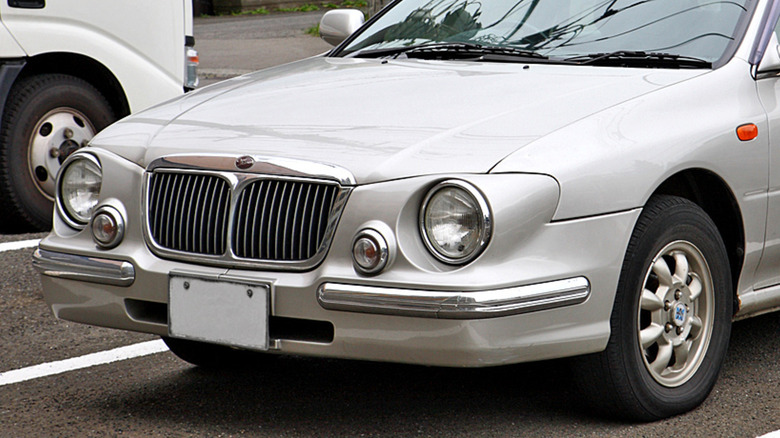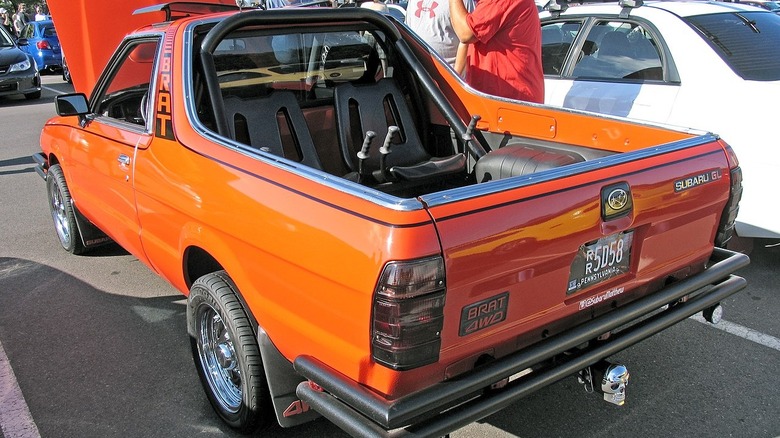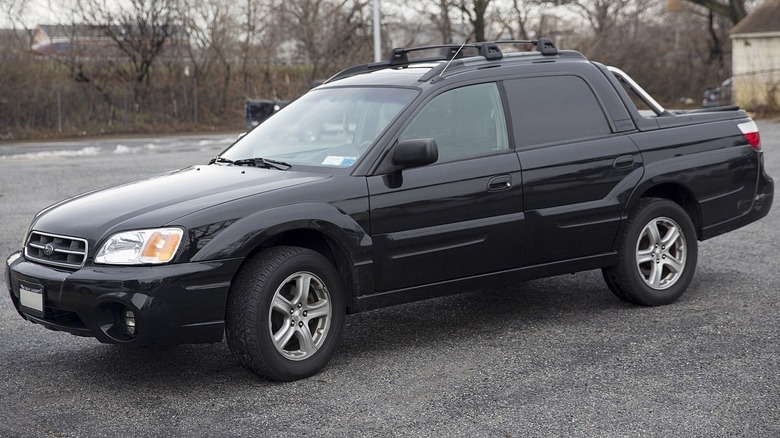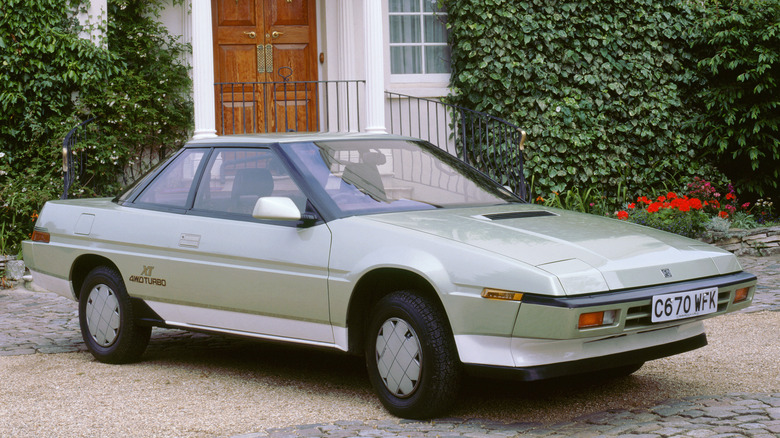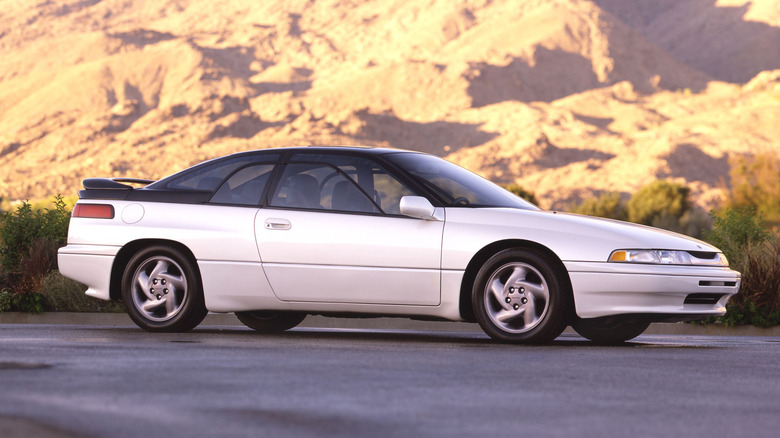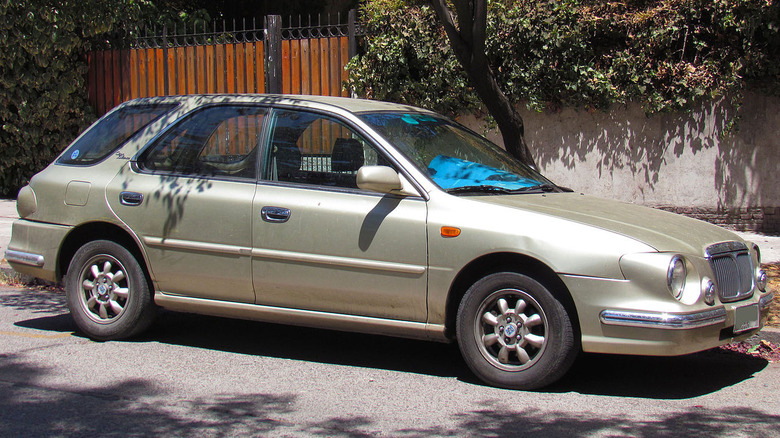The 5 Strangest Subarus That Made It To Market
When one considers Japanese automakers, the big three consisting of Honda, Nissan, and Toyota immediately spring to mind. However, what about plucky Subaru? Nowadays, they're a regular fixture on the roads of snowy locales like the northeast, where their signature all-wheel drive is a huge asset. For decades, however, the car-making arm of Fuji Heavy Industries struggled to find its identity.
First imported to the U.S. in 1968 with the aid of entrepreneur Malcom Bricklin of Bricklin SV-1 and Yugo fame — which might explain some of the weirdness — Subaru's inaugural vehicle to arrive on U.S. shores was the 360, a tiny rear-engined Kei car that may have been appropriate for urban Japan, but was considered a deathtrap on America's freeways due to lacking safety standards.
From there, we got pickup trucks with seats in the cargo bed, sports cars that were shaped like a doorstop, and wagons with gaudy retro styling grafted onto the front. Subaru has since redeemed themselves with hot hatches like the WRX STI, and immensely versatile crossovers such as the Outback, but let's take a walk down memory lane to revisit some of the brand's less mainstream endeavors.
[Featured image by Tennen-Gas via Wikimedia Commons | Cropped and scaled | CC BY-SA 3.0]
1978-1987 Subaru BRAT
Compact import pickups were hot in the 1970s, and later in the decade, Subaru wanted a piece of the action as well. Behold the BRAT; short for "Bi-drive Recreational All-terrain Transporter." Rather than a miniaturized traditional pickup truck like its competition, the BRAT was more like a tiny version of an El Camino or Ford Ranchero with its swept-back C-pillars — known as a "Ute" in certain parts of the world.
Based on the same platform as Subaru's Leone station wagon, the BRAT featured all-wheel drive, which could also be switched off at the driver's discretion. This effectively turned the BRAT into a front-wheel drive truck, saving fuel and wear on the drivetrain components — hence the "Bi-drive" moniker. Of course, the strangest aspect of the BRAT has to be the two rearward-facing passenger seats mounted in the bed of the truck.
The weatherproof plastic seats were added solely to avoid the 25% "chicken tax" that the United States placed on imported pickup trucks in retaliation for foreign taxes on poultry exports. By adding the rudimentary seats in the cargo bed, Subaru could claim the BRAT as a passenger vehicle and circumvent the tax.
Facing increasing pressure from safety organizations, the BRAT lost its signature bed-mounted seating in 1985, and was pulled from the U.S. market altogether in 1987, although it soldiered on for a few more years in other countries. One of the BRAT's most famous owners was former President Ronald Reagan, who drove one on his ranch near Santa Barbara, California.
[Featured image by Jacob Frey 4A via Wikimedia Commons | Cropped and scaled | CC BY 2.0]
2003-2006 Subaru Baja
Not content to let quirky pickup truck-esque vehicles die with the BRAT, Subaru rolled out its Baja for the 2003 model year. More practical than the BRAT, the four-door Baja had all of its seats inside the vehicle and facing forward like a normal car.
It was basically a stretched Outback SUV with a cargo bed instead of enclosed storage at the rear. Though the bed was only about three feet long, it had the catchy name "switchback," which consisted of a "bed extender" metal framework mounted to the tailgate, and a fold-down flap that allowed long items to pass through into the passenger compartment.
The Baja was not a sales success, and was unceremoniously dropped after only three years. American buyers found the ute concept and truncated cargo bed to be aesthetically strange. Additionally, the Baja was more expensive than a regular Outback, and nearly double the price of a small pickup like Ford's Ranger.
In hindsight, one has to wonder if the Baja was a great idea that was simply too far ahead of its time. If you squint a little, the Baja isn't all that different from Hyundai's current Santa Cruz "truck" and Ford's mega-popular Maverick.
[Featured image by Mr.choppers via Wikimedia Commons | Cropped and scaled | CC BY-SA 3.0]
1985-1991 Subaru XT
It's not every day that a car is best remembered for its steering wheel, but you could certainly make that case for Subaru's XT. Introduced for the 1985 model year, the XT sports coupe was highly futuristic, and at the time of its introduction, the most aerodynamic car sold in the United States.
A low coefficient of drag was important for the XT, because it certainly couldn't rely on brute horsepower to build speed. A pair of horizontally opposed "boxer" 1.8 liter four-cylinders was available, the hotter of the two producing a turbocharged 111 horsepower for the North American market. Later, a more powerful 2.7 liter six-cylinder engine with 145 horsepower joined the lineup.
Inside the XT's cabin — meant to be evocative of a jet — we find a joystick-style gearshift with a push-button for the optional all-wheel drive system, a totally digital instrument cluster that tilted with the steering column, and that infamous steering wheel itself. Its two asymmetrical spokes were shaped like an upside-down capital letter "L," or some say that it resembled a gun.
Everything about the XT was streamlined, including its exterior door handles, which were spring-loaded to be completely flush with the body when not in use. These humble Subaru door handles would later be appropriated by American manufacturer Vector for its short-lived $300,000 W8 supercar.
1992-1996 Subaru SVX
Buoyed by the success of the XT, Subaru upped the ante with its next coupe, the SVX, which was really more of a luxury grand tourer in the vein of an Acura Legend than a true sports car. The brand brought in designer Giorgetto Giugiaro — famous for cars such as the DeLorean and Lotus Esprit — to pen the lines of the SVX.
Like the DeLorean, the SVX had aviation-themed, window-within-a-window side glass that was said to reduce wind buffeting with the windows open at higher speeds. In fact, the entire greenhouse was either glass or glass-appearing materials, which really made it the focal point of the car.
Under the hood, the SVX was considerably more peppy compared to the outgoing XT. A 3.3 liter horizontally-opposed six cylinder made 230 horsepower, which was nearly as much as a V8-powered Corvette at the time. Of course, the SVX featured Subaru's signature all-wheel drive, and was only offered with an automatic transmission because Subaru didn't have a manual transmission capable of handling that amount of power.
At its 1992 debut, the SVX was priced between $24,445 and $28,000 depending on trim level ($55K to $62K in today's money), which was many thousands higher than any previous Subaru had cost, and that price only rose in subsequent years. The brand hoped to sell 20,000 units of the SVX annually, but couldn't even hit that figure across all five production years combined.
1999-2000 Impreza Casa Blanca
Some readers may remember the retro-car craze that swept the United States at the turn of the 21st century, bringing us such abominations as the Chrysler PT Cruiser, Ford Thunderbird (okay, that one isn't so bad), and the Chevrolet SSR. Japan participated in the retro trend as well, and the classy machine featured here is Subaru's Impreza Casa Blanca which unfortunately (or fortunately?) was not exported westward.
The Impreza Casa Blanca looks like an AMC Pacer rear-ended by a classic Jaguar, but apparently, 5,000 buyers signed up to buy the one-year-only wonder. With an all-new second-generation Impreza soon to hit the market, some enthusiasts believe that the limited edition Casa Blanca was conceived to maintain interest in the dated outgoing body style.
Oddly, it was only available as a variant of the base model Impreza, which has a non-turbocharged 1.5 liter four-cylinder that made an anemic 95 horsepower.
[Featured image by order_242 via Wikimedia Commons | Cropped and scaled | CC BY-SA 2.0]
